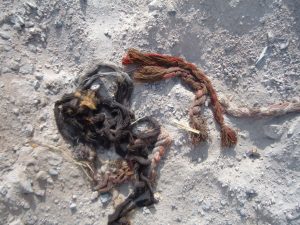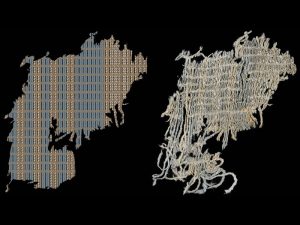Humans began to deliberately use color to express themselves and to enhance their environment early in their development. It’s hard to set a precise date, since so little evidence of past human activity remains. We know that in Chauvet Cave in France, as early as 32,000 years ago, artists used scraping, incising, and charcoal, ochre and other pigments to depict black, red and yellow animals, geometric features and “stencils” of human hands. Ochre also occurs in Neanderthal and other burials sometimes dated by archaeologists to 40,000 BC.
Much closer to our current era, pottery with painted designs appears by 6,000 BC in the Middle East, and geometric designs in three colors were produced by the Halafian culture in Iran by around 4,500 BC. In China, Yangshao painted pottery dates to approximately the same period.
It’s much more complicated to get evidence of colors deliberately applied to fabrics. In order to be analyzed, textiles have to survive their era of use. There’s a reason the Society for American Archaeology calls one interest group “Fiber Perishables”. Preservation conditions for textiles in most temperate or tropical areas of the world are horrible. Should they be discarded after the damage incurred by normal wear and tear, they are subjected to mold, destruction by insects or other natural agents. Where they are found in contexts which preserve them, such as bogs, very often chemical changes have occurred which interfere with further analysis. Sometimes the “ghost” of the fiber object remains, as when newly-made pots are left to dry on a woven mat and the bases are marked by the mat, or when a bundle of ceramic offering vessels is wrapped in a cloth and buried. The vessels remain, in the position in which the offering was buried, but the cloth around them has rotted away and been incorporated into the soil around it.
Occasionally we get lucky. Extreme dryness creates the ideal conditions for the preservation of textiles. While we tend to think of deserts as very hot, like Death Valley or the Sahara, heat isn’t a requirement for an arid area to exist. There are cool deserts, both inland (the Tarim Basin in Central Asia), and along coastlines (Namibia and Peru). Well-preserved textiles have been found in Egypt and coastal Peru for many years; those from the Tarim Basin are best known to us from Elizabeth Barber’s book “The Mummies of Urumchi”.

Burial goods photographed in Peru. Probably Huari culture 500-1600 AD. Probably unsalable loot left behind by grave robbers.
Ancient textiles and textile technology have been extensively analyzed. Characteristics of yarns, Z twist or S twist, spindles, drop or supported, and of various types of looms have been documented by artists or textile scholars . Techniques, such as twining, scaffold weaving and netting have both been studied and replicated by modern researchers. The age of archaeological textiles has been established both by stratigraphic methods and by radiocarbon dating. Until relatively recently, less attention has been paid to dyes, possibly because early laboratory dating and analytical techniques required the sacrifice of more of the scarce materials than archaeologists or museums were willing to permit.
Although there has been a lot of speculation about what dyes were used and how early they might have been used, there has been little evidence available prior to the Greco-Roman period in the Mediterranean. What evidence we do have from earlier periods, however, shows that textile dyes have a long history.
Ochre was used to create red colors from the earliest times. Ochre (or ocher) is a naturally-occurring mineral pigment, a hydrated iron oxide, and can be remarkably persistent. It also occurs in yellow forms (Yellow Ochre) and is used as well. Blue is another problem. Aside from some blue clays, there isn’t a mineral parallel to ochre. The best natural source of blue pigments is from plants.
Fortunately, nature provides plenty of plant sources for blue colors. The two best-known plant families producing blue are indigo (Indigofera spp) and Isatis spp., from which woad is derived. Indigofera is distributed worldwide across the tropics and subtropics; of the six principal cultivated strains, suffuticosa grows in the tropical Americas, tinctoria is used in Indonesia for batik, sumatrana was taken to India from Malaysia by the Dutch, two more are African varieties and longeracemasa comes from Madagascar. By contrast, Isatis spp is broadly distributed across the temperate zones, particularly in Europe, but not in hotter climates.
There are also other, unrelated plants, from which blue dyes can be derived. What nature does NOT provide is guidance in selecting the plants which will produce these dyes or a handy guide for extracting them. The logic of similarities doesn’t work. ”It looks blue, so maybe it will make blue” is no help; many Indigofera varieties have red, yellow or white flowers. Some of these varieties are shubs or bushes; Isatis grows entirely differently, looking nothing like the indigo family.
Nevertheless, humans around the world seem to have come to similar conclusions about how to use the plants’ potential to create a blue pigment. The process has two stages: first, the indican in the Indigofera or Isatis foliage is converted to glucose and indoxyl, traditionally by soaking it in urine or a similar substance, then, when the indoxyl is exposed to oxygen, particles of indigotin are precipitated. That’s what dyes stuff.
It’s not clear who was first to domesticate indigo, though it might have been the very early Harappan civilization, spanning southern Pakistan and western India, with blue cloth fragments found at Mohenjo-Daro dated to 1750 BC and seeds from 4 indigo species at Rojdi (2500-1700 BC). By 600 BC in Mesopotamia, there is a tablet detailing how to create various intensities of color in wool by the repeated dipping into a dye bath. From Egypt at a much earlier date, 2400 BC, there is a linen mortuary wrap with a blue border .
Both the Egyptian fabric and the Mesopotamian tablet were once thought to refer to indigo. This cannot be proven, because the pigments are essentially identical in composition. It is more likely that the coloring agent, particularly for the Egyptian textile, is woad. Many native woad species grow in Turkey, which had contacts with adjacent Mediterranean areas very early. There is no record of trade across the Arabian Sea or overland from India at such an early date. It’s probable that archaeologists just reasoned back from the known use of indigo in the Greco-Roman period and assumed that if blue existed, it was dyed with indigo.
Woad , a distant relative of cauliflower and broccoli, has a deep history in Europe, the steppe lands across Central Asia and the Middle East, being found in caves and other sites as early as the Neolithic. Woad-dyed fabrics are known from the lakeside ruler burials of the Hallstatt culture.
Though there was a period when it was believed, the use of woad as body paints and tattooing by the Britons, also known as Iceni or Picts, has been disputed by almost every recent scholar except Mel Gibson. Julius Caesar’s report seems to refer to a blue-green color more likely obtained from copper-based substances, and the Northern warriors had dropped using whatever the substance was some centuries before “Braveheart”.
In fact, the presence of indigo dyes in European textile production was vigorously resisted, up through the early stages of the Industrial Revolution. Woad production was thriving in France and other European countries throughout the Middle Ages, and was a substantial source of support for local economies. Colbert, Louis XIV’s financial minister, made a strong protectionist argument against the importation of indigo, which he saw as weakening local woad producers and therefore government revenues. The counter-argument came from dyers, who claimed that indigo was superior to woad, since the effective pigment was so much more concentrated.
So which came first, woad or indigo? We’ll never know. We do now know, however, that “first” is a lot earlier than previously documented. As mentioned before, the coast of Peru is among the optimal sites for preservation of perishable materials. It is a cold desert, averaging only a centimeter or so of precipitation per year. Chilled by the Humboldt Current, which creates conditions for very rich marine resources, the coast has supported populations from very early periods. Where rivers flow from the Andes, valley soils are irrigated and very productive. Naturally colored, perennial cotton (Gossypium barbadense) is thought to have been domesticated somewhere along the north coast. The oldest evidence, dating to about 7800 years ago is from the Nanchoc Valley in the region.
In recent decades, as archaeologists have moved away from their obsession with monumental architecture and a now beginning to investigate societies at the domestic level, their attention is turning to studying some less glamorous material from past excavations. This trend has now begun to influence Andean archaeology. 6,000 year old textiles excavated from Huaca (or Wak’a) Prieta (Brown Hill/Sacred Site/Ruin) in north coastal Peru more than half a century ago have now been analyzed using high-performance liquid chromatography. The oldest, a blue and natural tan cotton weft twined fragment, showed a profile of the two components of indigo dye (indigotin and the isomer indirubin) which is characteristic of “blue-dyed textiles from China, India and Latin America as compared to those of European origin”. In other words, we can interpret this archaeologist-speak as confirming the existence of indigo dye in a 6,200 year old Peruvian textile.

This is the 6,200 year old textile and the study drawing
This discovery, published less than six months ago, may energize researchers in other parts of the world to begin a closer study of some previously disregarded material from their excavations. Can we expect to find even earlier evidence of the dyer’s hand?